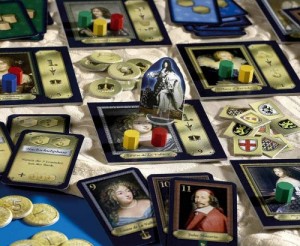Review: Louis XIV
Posted by James (admin) on September 11th, 2010
 Louis XIV is mostly a worker placement game but it’s quite unusual. First of all, there’s no board; instead, there are 12 mini-boards laid out corner-to-corner in a square grid – this makes it easy to flip over any of the mini-boards but it also leaves spaces where various tokens get placed too. Over 4 rounds, players try to earn as many victory points as possible. Players can earn many VPs by fulfilling their mission cards which are completed by collecting the power chips shown on each card. There are 4 types of power chip as well as one type that counts as any type.
Louis XIV is mostly a worker placement game but it’s quite unusual. First of all, there’s no board; instead, there are 12 mini-boards laid out corner-to-corner in a square grid – this makes it easy to flip over any of the mini-boards but it also leaves spaces where various tokens get placed too. Over 4 rounds, players try to earn as many victory points as possible. Players can earn many VPs by fulfilling their mission cards which are completed by collecting the power chips shown on each card. There are 4 types of power chip as well as one type that counts as any type.
Each round, players receive 5 cards – each card corresponds to one of the 12 mini-boards. Each turn, players can play one of their cards and place up to 3 of their cubes (workers) from their supply onto the mini-board that matches their card. Also, they can move any of the newly placed cubes onto an adjoining mini-board so long as they leave at least one cube behind and do not spread in two different directions at once from the same mini-board. As players only have a limited amount of cubes, they can use their turn to add some cubes to their supply instead of placing. Players discard the last card left in their hand so usually get 4 turns.
So, why place cubes? At the end of each round, the mini-boards are resolved in order. Each mini-board gives a different benefit (such as gaining power chips, money, coats of arms, special cards that give players extra powers) but what is gained, and how it is determined, depends not only on the mini-board but also on which side of the mini-board is showing as all boards are double-sided. It’s a bit complex at first so I’ll try to explain. First, boards are resolved in one of three ways:
1. The player with the most cubes gets the benefit and no-one else gets anything
2. Players can spend their cubes on the mini-board to get the benefits
3. Players can spend cash to get the benefits
In all cases, the player with the most cubes on a mini-board gets the benefit at no cost. If other players can use the benefit then anyone with their cubes on the board being resolved can choose to pay cubes or cash (depending on the board’s requirements) to use the benefit. If the benefit of a board is used it gets flipped over for the next round – each board always gives the same benefit but the two sides have different ways in which the benefit can be earned. In addition to this, the king figure is placed at one of the mini-boards (determined each round by a card) and this board gives an extra benefit too.
Once all the mini-boards have been resolved, players can fulfil any of their mission cards by discarding the relevant power chips. As a well as 5 VPs at the end of the game, each fulfilled mission card gives its owner a special ability to use for the rest of the game too. There are three levels of mission card – the harder they are to fulfil (by being more specific in the power chips required), the better the ability.
At the end of the game, VPs are earned for fulfilled mission cards, coats of arms, cash, unused special cards, plus there are bonus VPs for having the majority of the 6 different coats of arms.
 It sounds more complex than it is, although it did take us a round to settle into it. In essence, it’s a worker placement game but it’s definitely different to other games due to the way the cubes get placed, the way benefits are earned, and the way the game changes as the boards get flipped. Earning power chips seems the most important aspect so you can fulfil mission cards – you need to keep focused on how these can be earned too as it’s not always the same because of the way the boards flip.
It sounds more complex than it is, although it did take us a round to settle into it. In essence, it’s a worker placement game but it’s definitely different to other games due to the way the cubes get placed, the way benefits are earned, and the way the game changes as the boards get flipped. Earning power chips seems the most important aspect so you can fulfil mission cards – you need to keep focused on how these can be earned too as it’s not always the same because of the way the boards flip.
The game gets a bit fiddly because of the different ways that the boards get resolved which is compounded by various rules for resolving ties . Also, when a mini-board is resolved, your cubes are returned to your own supply in some cases, but go to the general pile in others. So, it can feel fiddly because there are a lot of simple but slightly different rules for different situations, and not just a few common rules. After a round or two, the rules were more obvious but it did take a while to get used to.
Mission cards are the key way to earn points (5 VPs each) and the special ability they give you when completed can be really useful. Also, the special abilities make it interesting because each player ends up playing from a slightly different position. It would be nice to have more control over what ability a mission card will give you when it’s completed, rather than luck of the draw, but it needs to be a blind draw so the player can’t see which power chips will be needed to compete it.
Luck plays a bit of a part too when it comes to which chips you need to complete a mission – both because you may have some of the required chips already, but also because some chips are easier to obtain during a round than others (i.e. it’s easier to get ones from mini-boards where you can buy them compared to ones earned by having most cubes).
I like how the game tries to inject something different into worker placement games. Finding different ways to gain the chips you need to complete missions was an interesting task and you often need to re-assess things as the situation changes. However, I think a bit of streamlining to reduce the variety of different situations/rules would help and, without that, I think it’s a game you need to play once before you can really play it fully. Louis XIV was an interesting and enjoyable game to play – I’m not sure how often I’d play it but I would play it again.
James.
[Played with 4 players]

